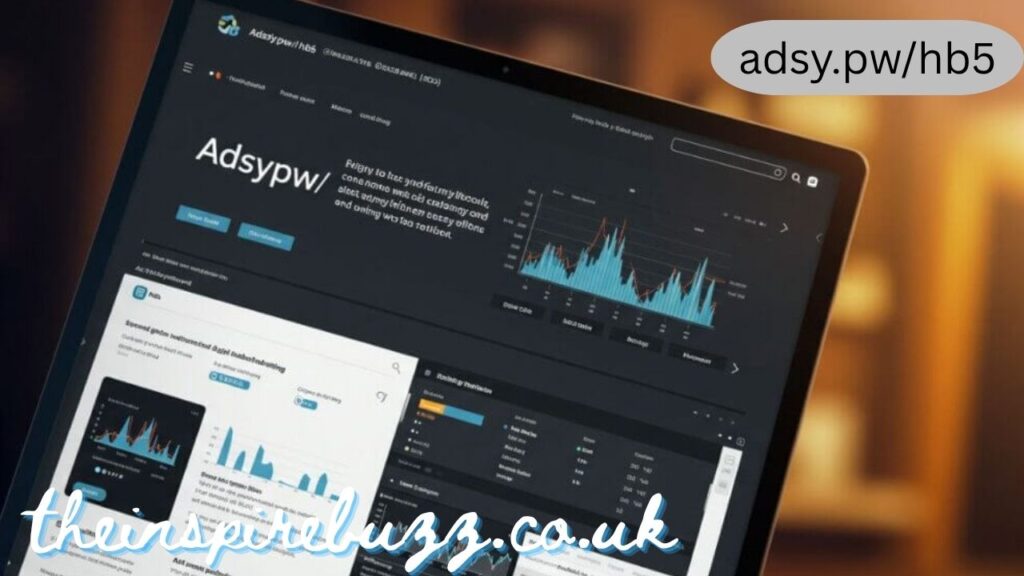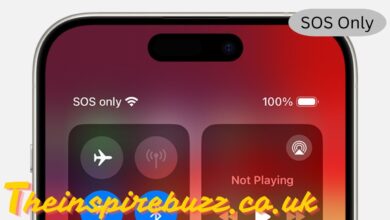Discover How adsy.pw/hb5 Transforms Digital Marketing and Online Success

Introduction
In the evolving landscape of digital marketing, tools that seem simple often carry deeper functionality. One such link is adsy.pw/hb5 — on the surface it looks like a short URL, but behind it lies a wealth of tracking capabilities, marketing funnels, and uncertainty. In this article you will discover what adsy.pw/hb5 really is, how it works, where people use it, what risks it carries, and how smart users can benefit from or avoid its pitfalls.
This article is designed not only to explain but also to warn, guide, and empower. Whether you are a marketer, content creator, or cautious netizen, reading this will help you make informed decisions when encountering or using adsy.pw/hb5.
What Exactly Is adsy.pw/hb5?

When you see adsy.pw/hb5, it’s more than a random string — it is a smart short link. In many digital marketing campaigns, such links are created to route users through redirect servers, collect click data, and then finally send them to a target page. Rather than exposing the full destination URL (which may contain tracking parameters, affiliate codes, or complex directories), the short link conceals complexity.
Technically, the domain “adsy.pw” acts as the shortener’s host, and “/hb5” is the unique slug or identifier for a specific campaign or destination. That slug could map to any landing page, a product site, a lead capture form, or even a rotating set of destinations. The creator of that slug retains control over where it resolves and how the analytics are tracked.
How Does adsy.pw/hb5 Work Behind the Scenes?
The mechanism is multi-step. First, a long URL (which may include campaign parameters, affiliate IDs, or UTM codes) is converted into a short version like adsy.pw/hb5. Then, when a user clicks it, a redirect server logs information: IP address, browser agent, device type, click timestamp, geographic location, referrer, etc. After logging, the system forwards the user to the intended target.
Additionally, more sophisticated setups can include intermediate landing pages with interstitial ads or popups, provide A/B testing (rotating multiple destination URLs), or dynamically change the target depending on the user’s region or device. In some cases, the slug “hb5” might itself be repurposed later to point elsewhere, making the short link itself a dynamic asset.
Why Is adsy.pw/hb5 Gaining Attention in 2025?
Short links are nothing new. But adsy.pw/hb5 appears frequently now in social feeds, influencer posts, ad comments, and affiliate promotions. Its rise is driven by the demand for clean-looking links plus embedded analytics that marketers crave. As organic reach becomes more difficult on social platforms, marketers prefer to push traffic via crafted short links rather than raw long URLs.
Another reason is that users today are more mobile-first. Compact links fit better in character-constrained captions, SMS, Instagram bios or stories, or even QR code placements. Also, general users are less likely to mistrust a short branded link than a long, messy URL full of random parameters.
The Core Features & Capabilities of adsy.pw/hb5
Behind the façade, adsy.pw/hb5 (or the system behind it) often supports: click analytics (device breakdown, geography, time), custom slug control, redirect control (you can change the final destination), link expiration or deactivation, A/B split-testing, password protection, and campaign segmentation. Some versions may also integrate with external analytics or marketing dashboards.
These features let marketers monitor performance, refine campaigns, and control user experience. For example, if a campaign underperforms, the marketer could switch the destination of adsy.pw/hb5 to a new offer without changing the link itself. That flexibility is powerful.
Use Cases: Where People Use adsy.pw/hb5
Marketers and creators employ adsy.pw/hb5 in multiple scenarios. One is affiliate marketing: share a short link in a post, route visitors through a funnel, and track conversions. Another is content promotion: embed adsy.pw/hb5 in social media posts or newsletters so you can see how many clicks came from which platform or region.
Also, adsy.pw/hb5 is used in influencer campaigns, where influencers share the link and the originator can track performance across different promoters. Sometimes brands hide offers (lead magnets, free trials) behind short links to gate them, while still measuring engagement. In offline campaigns too — printed materials or QR codes — a short link like this is easier to print, type, or scan.
Safety, Risks & Red Flags of adsy.pw/hb5
While short links are neutral tools, misuse can lead to harm. The risks include redirecting users to malicious sites (phishing, malware installers), cloaking unwanted ads or overlays, or sending people into endless funnels demanding payments or subscriptions. Because the final destination is hidden until click, users can be tricked.
Some red flags include: extremely aggressive upsells, repeated popups demanding payment, requests for sensitive personal data (like credit card info) without transparency, or sudden downloads. Also if adsy.pw/hb5 appears in unsolicited messages or strange sources, one should be cautious. Always preview or scan before clicking.
How to Preview or Validate a Short Link Like adsy.pw/hb5
Before clicking, use a link expander tool (like Unshorten.me or CheckShortURL) to see where adsy.pw/hb5 leads. Another method is to paste the link into a URL scanner (e.g. VirusTotal) to see if it’s flagged. You can also copy the link and open it in a safe sandbox or isolated browser. Checking WHOIS or domain reputation sometimes helps too.
By doing this, you can decide whether to trust the link. If the destination looks suspicious or the expanded URL is opaque, avoid it. Many security-conscious users adopt this precaution routinely when encountering short links they did not expect.
Ethical & Legal Considerations for Marketers Using adsy.pw/hb5
If you use adsy.pw/hb5 in your campaigns, you should maintain transparency. If the link leads to an affiliate or paid product, disclose that to your users (FCC/FTC rules in many jurisdictions). Do not mislead people with false promises or disguised fees. Also, avoid redirects to prohibited content, phishing pages, or deceptive sites. Abusing users’ trust may lead to legal or reputational damage.
Marketers should also manage data responsibly — anonymizing or aggregating where possible and being cautious about collecting personally identifiable information without consent. Ethical use ensures long-term sustainability.
How adsy.pw/hb5 Impacts SEO & Analytics
Strictly speaking, a short link like adsy.pw/hb5 doesn’t directly boost SEO in search engines (Google doesn’t count a short link as a backlink). But indirectly, it helps marketers monitor traffic sources, measure campaign ROI, and refine content strategy. By placing such links in blog posts, social media, or newsletters, you can see what content types resonate, then adapt SEO content accordingly.
Also, since you can swap destinations behind the same link, you might test multiple landing pages for conversion and choose the best performing one to link permanently — improving user metrics, engagement, and ultimately SEO signals on your main domain.
Best Practices for Using adsy.pw/hb5 Wisely
When deploying adsy.pw/hb5, start small. Test on low-stakes campaigns before using on high-traffic fronts. Always label or contextualize links (so users know where they go). Use UTM parameters behind the scenes for deeper analytics. Avoid overuse of popups or forced flows. Monitor performance and be ready to shut off links that misbehave. Use HTTPS and secure hosting. Finally, be responsive to user complaints and always provide a fallback or alternative.
Real-World Examples & Reported Experiences
Some users report that adsy.pw/hb5 was used in affiliate product promotions, especially in health or supplement niche funnels, with video sales letters and upsell chains. Others saw it in influencer bios, shared across Instagram stories or TikTok captions. In many forums, people have complained about aggressive redirects or being forced into subscription pages.
On the positive side, marketers sometimes praise its ability to centralize and track multiple campaign sources via a single link. But these experiences vary — one user claimed that one campaign generated 200 leads in days via adsy.pw/hb5, while another said they were trapped in endless popups and had to close the tab.
Comparative Tools & Alternatives to adsy.pw/hb5
There are many link shorteners and campaign tools: Bitly, TinyURL, Rebrandly, Pretty Links, and link tracking suites. These alternatives are more established, sometimes more transparent, and possibly safer. The advantage of adsy.pw/hb5 might be its aggressiveness in tracking or funnel flexibility, but the downside is trust and unpredictability.
If you prefer reliability, use known platforms with good reputations. Use adsy.pw/hb5 only when you’re comfortable with risk and have contingency plans. Always compare features, cost, analytics depth, and reputation before deciding.
Troubleshooting Issues with adsy.pw/hb5

If adsy.pw/hb5 fails to resolve, the slug might be deactivated or expired. Try clearing your browser cache, or using a different browser. If the target page seems broken, check the expanded URL. For marketers, if analytics show no data, the tracking script or redirect chain might have been misconfigured. Also ensure there’s no conflict with ad blockers or privacy plugins that block redirect logging.
Some users find that mobile redirection fails, possibly due to misconfigured device targeting — test across devices. Always maintain backups of your original landing pages and UTM links.
The Future of Short Links & What adsy.pw/hb5 Suggests
Short links will likely evolve to become smarter: more dynamic routing, deeper personalization (user segments, predictive content), and stronger security (with link previews, captcha gating, anti-abuse filters). adsy.pw/hb5 may be an example of that trajectory — where a simple slug becomes a mini marketing hub.
We might see short links integrating AI to auto-optimize destination based on performance. Or protocols where users can preview or vet a short link before clicking. The future holds more user control as privacy concerns grow.
When to Avoid Using adsy.pw/hb5
Avoid using adsy.pw/hb5 in sensitive contexts (banking, financial transactions, login forms). Do not use it in unsolicited messages or spammy posts. Avoid it if you are unsure about the destination or do not control the backend. If the link is shared by unknown parties, treat it as suspect. If your audience is privacy-conscious, using transparent direct links may build more trust than hidden short links.
How to Educate Your Audience About adsy.pw/hb5
If you must share adsy.pw/hb5, accompany it with explanations: “Use this link to claim the free guide,” or “This link leads to our landing page.” Encourage users to verify links. Publish transparency statements on your site or campaign. Provide alternative direct links for users who are uncomfortable. That builds trust.
Summary & Final Verdict
adsy.pw/hb5 is a potent short link tool — combining redirect mechanics, analytics, and campaign control. But with power comes risk: it can be misused to cloak malicious or deceptive content. If you plan to engage with it, do so with caution. Always preview, validate, monitor, and maintain transparency. For serious campaigns, consider safer, vetted alternatives. Use adsy.pw/hb5 only when the tradeoff (flexibility vs risk) is acceptable to you.
Also Read: What Is Traffic Impact Assessment – Meaning, Method, Process, and Importance Explained




